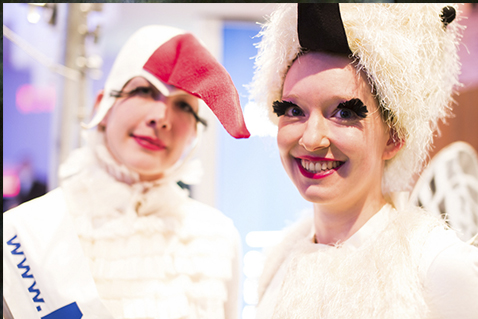wanderlust
C’mon, Bat Your Lashes At Berlinale’s Arty Side

Well folks, it’s that time again—Berlinale time. The world’s most widely attended film festival has touched down in Berlin, and it would seem that the plastics arts have taken a backseat to film, at least until February 17th. And although George Clooney, James Franco, Joseph Gordon-Levitt, movies, movies, and more movies may be the talk of the town, those in the know are just as eager to partake in The Berlinale 8th Forum Expanded, which ventures far beyond film into the realms of contemporary art with an avant-garde exhibition of new media work at silent green kulturquartier, the former crematorium in Wedding.
According to the program, “The title of this year’s group exhibition ‘Waves vs. Particles’ is taken from a theoretical approach employed in quantum mechanics which claims that all forms of radiation exhibit both wave and particle properties, with only one or the other actually being detectable depending on the particular experiment being carried out. The experiments here form an eclectic mix, taking in ocean waves and sound waves, radioactivity and psychology and national guilt and responsibility.”
This insightful piece of academic art-speak I engaged with only after leaving the hallowed halls of the former crematorium, it being my habit generally to enter an exhibition without any preconceived notions about the concept or quality of the work, form my own conclusions, and then grapple with the curatorial material. I have to say, in this case, I feel all the more enlightened for my post-game research.

You see, my experience of “Waves vs. Particles” is the story of a house, or rather a crematorium, divided. Three of the pieces in the seven piece show spoke to me in a way few pieces of art, video or otherwise, ever have. Haunting, gorgeous, evocative, immersive, I stayed twice as long as I planned and I’m already planning a trip back. But we’ll get to more of the good later, unfortunately it might be best to clear the bad and the ugly out of the way first, complicated as that may be.
I should begin by explaining that often I feel entitled, even obligated, to pass judgment on the work I’m engaging with in a professional capacity. Of course my opinion is only one of many, informed by my preferences, context, and even mood. However, it seems to me that one of the duties of a reviewer is to review; that is, to say who won and who lost, who’s up and who’s down, what’s good and what’s bad. In this case, the work I previously labeled bad and ugly, didn’t strike me as being of particularly poor quality, conceptually or formally, and so I hesitate to write it off completely. Yet, I found myself literally tapping my pencil along the spirals of my notebook checking the runtime of certain pieces as I gauged how long I would really have to listen to monologues in foreign languages, sans-subtitles, as apparently unrelated and uninteresting images rotated on screens in front of me.
| Continued on Page 2 |
Be the first to write a comment.
Your feedback
